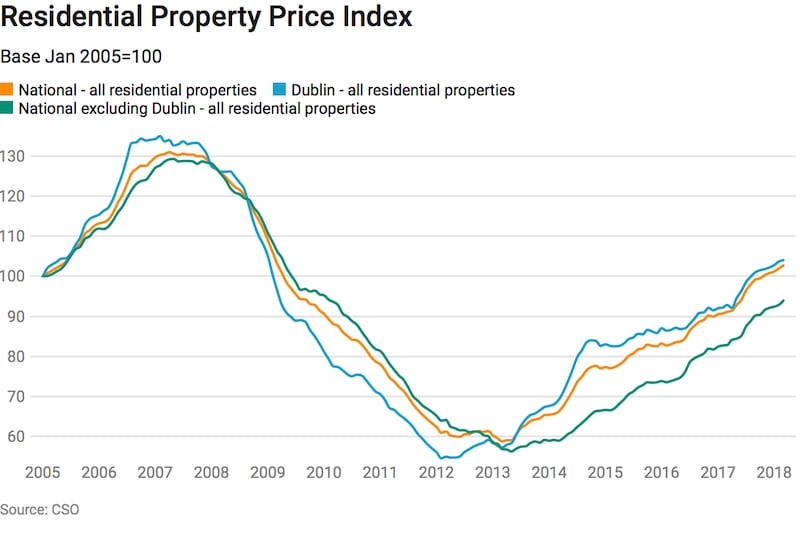The property market is showing no signs of cooling with prices accelerating by 12.7 per cent in the year to March. This compares to an annual increase of 12.5 per cent in February.
The latest official figures from the Central Statistics Office (CSO) are at odds with recent reports from property websites MyHome.ie and Daft.ie, which both reported a slowdown in headline inflation.
The CSO figures show annual price growth in Dublin, where demand is greatest, is now running at 12.1 per cent, down from 12.7 per cent the previous month.

The highest house price growth in the capital was in Dublin city, at 14.2 per cent while the lowest growth was in south Dublin, where house prices increased 9.6 per cent.
In Dublin, prices have risen by 90.8 per cent since the low point of the crash in February 2012, and are now 23 per cent off their 2007 peak.
The most expensive Eircode area to buy a house was Dublin 4, with an average price of €762,913. The CSO figures show the 10 most expensive Eircode areas by mean or average price were in Dublin.
Property prices in the Republic, excluding Dublin, were 13.4 per cent higher in the year to March.
The west region showed the greatest price growth, with house prices increasing 18 per cent while the Border region showed the least price growth, with house prices increasing 8.8 per cent.
Outside Dublin, the most expensive Eircode area to buy a home over the last 12 months was Greystones, Co Wicklow, with a mean price of €424,534 while the least expensive Eircode area was Ballyhaunis in Co Mayo, with a mean price of €75,415.
Responding to the latest price figures, Brokers Ireland warned that unless supply of properties ramps up more quickly in the near future a whole generation now in their late 20s and 30s, and even beyond, may never be able to recover the financial loss of not being able to acquire a home at an affordable price.
Rachel McGovern, director of financial services at the organisation which represents almost 1,300 firms, said supply is crucial to bring some level of stability back into the market.
“Throughout the country it’s cheaper to buy a property, if you can get one, than rent,” she said.
“The hunt for the elusive property has become a constantly moving target that has become the norm since the recovery, which came following several barren years after the financial crash,” she said.
Goodbody analyst Dermot O’Leary homed in on housing transactions, which fell 4 per cent to 13,967 in the first quarter, a decline that was linked to poor weather conditions.
Dragged down
This performance was dragged down by a 26 per cent year on year decline in
“institutional” purchases. The figures show owner-occupier transactions fell by 1 per cent on an annual basis, while first-time buyer transactions increased by 13 per cent in the first quarter, driven by a 50 per cent increase in first-time buyer purchases of new homes.
Over the past 12 months, there has been 60,650 housing transactions, the figures show.
“While new homes are accounting for a larger share [17 per cent currently], there has been a plateauing in total transactions over the past six months,” Mr O’Leary said.
“Relative to the housing stock, this remains low historically, with liquidity held back by the current record low level of stock for sale.”















